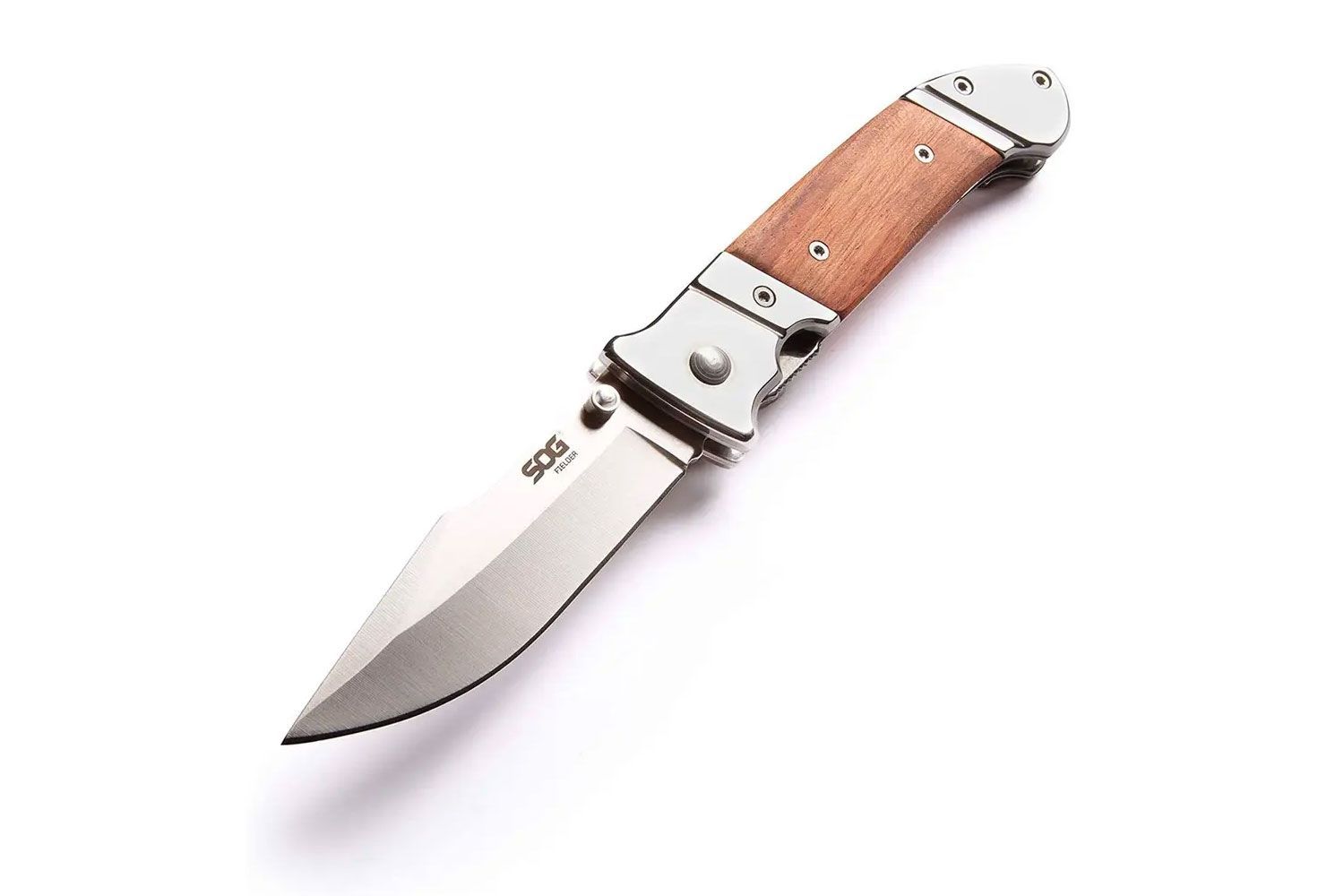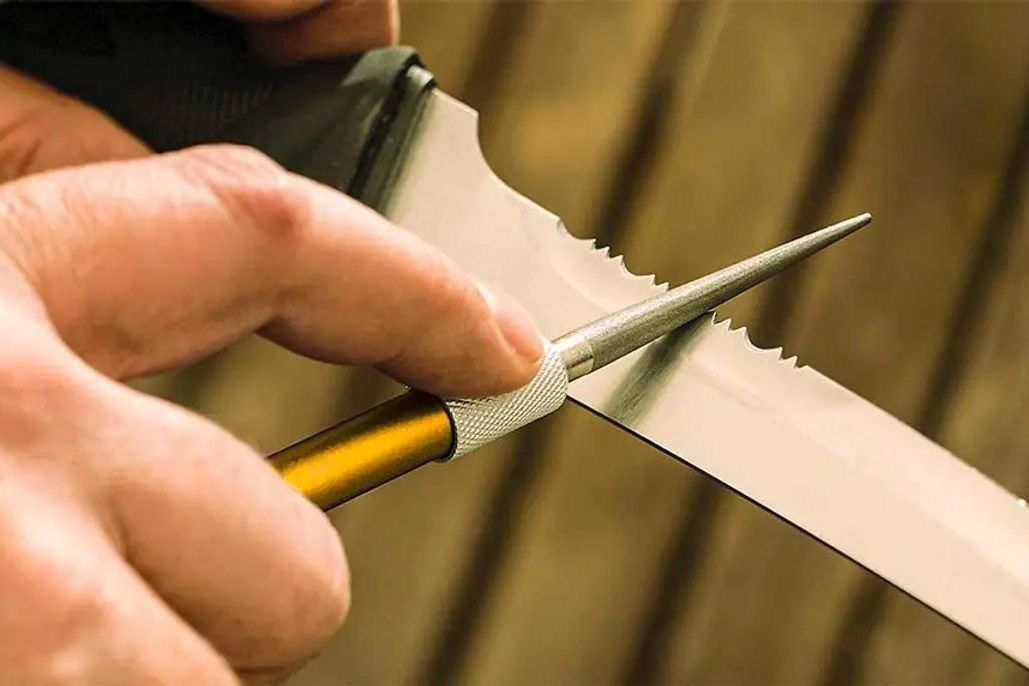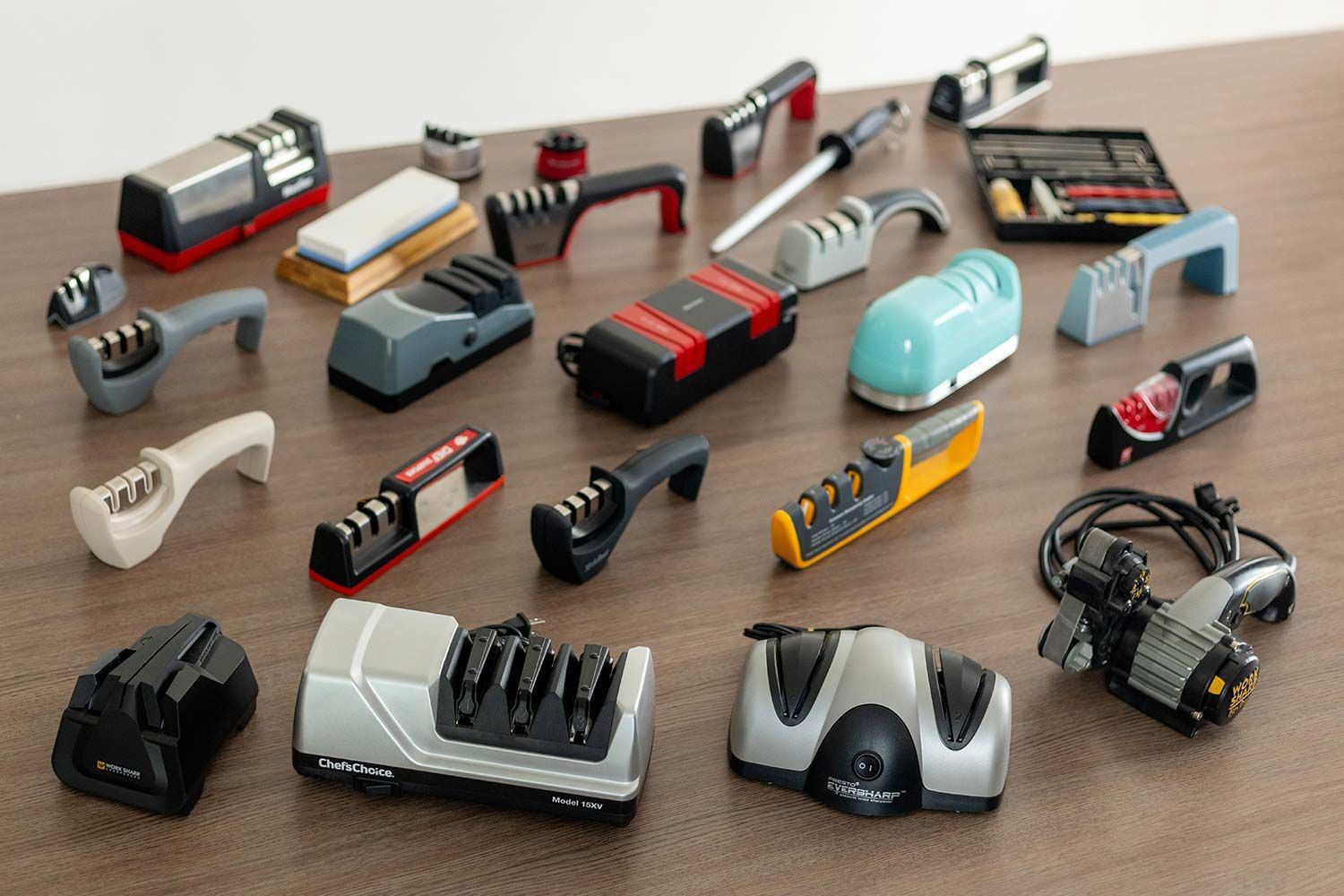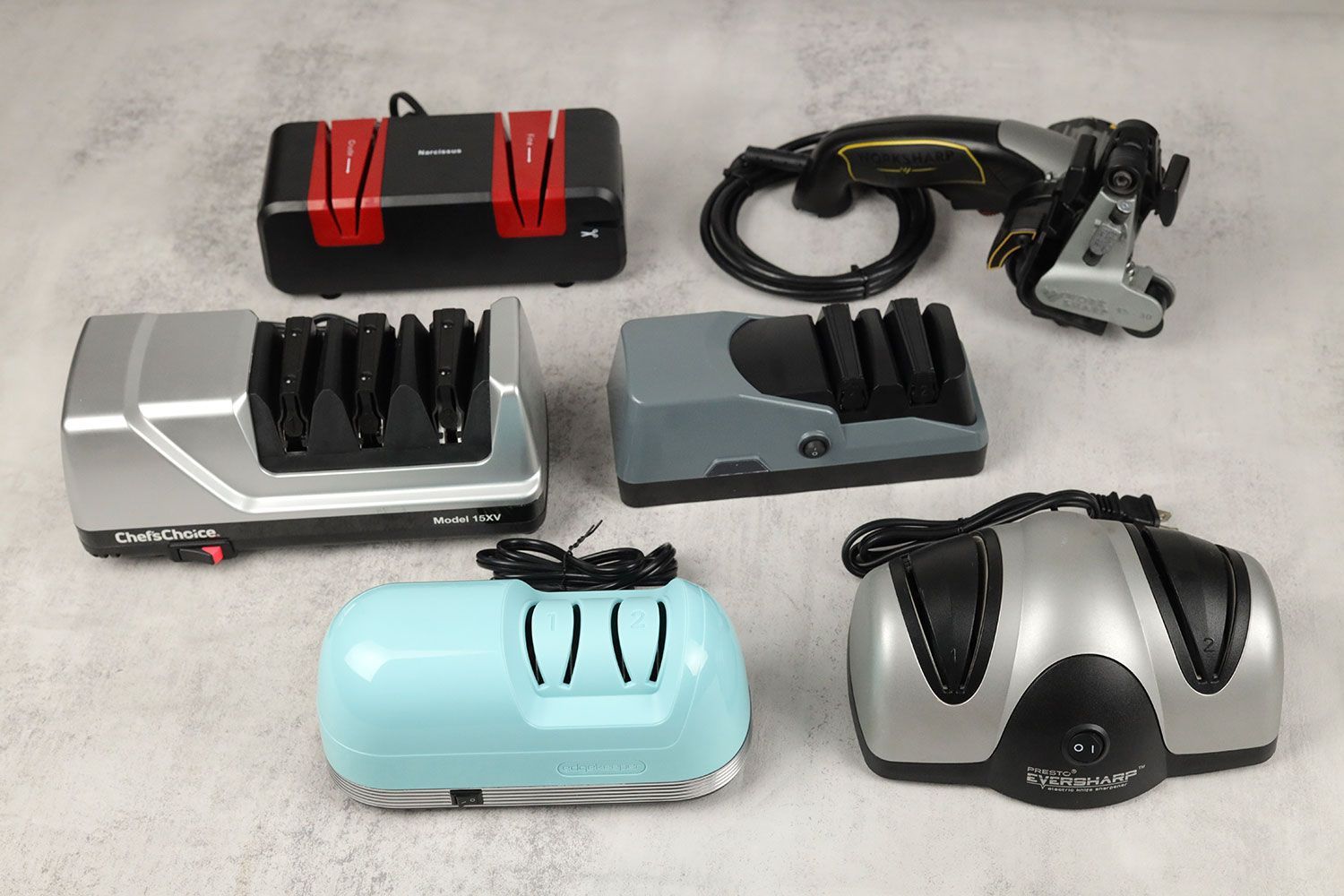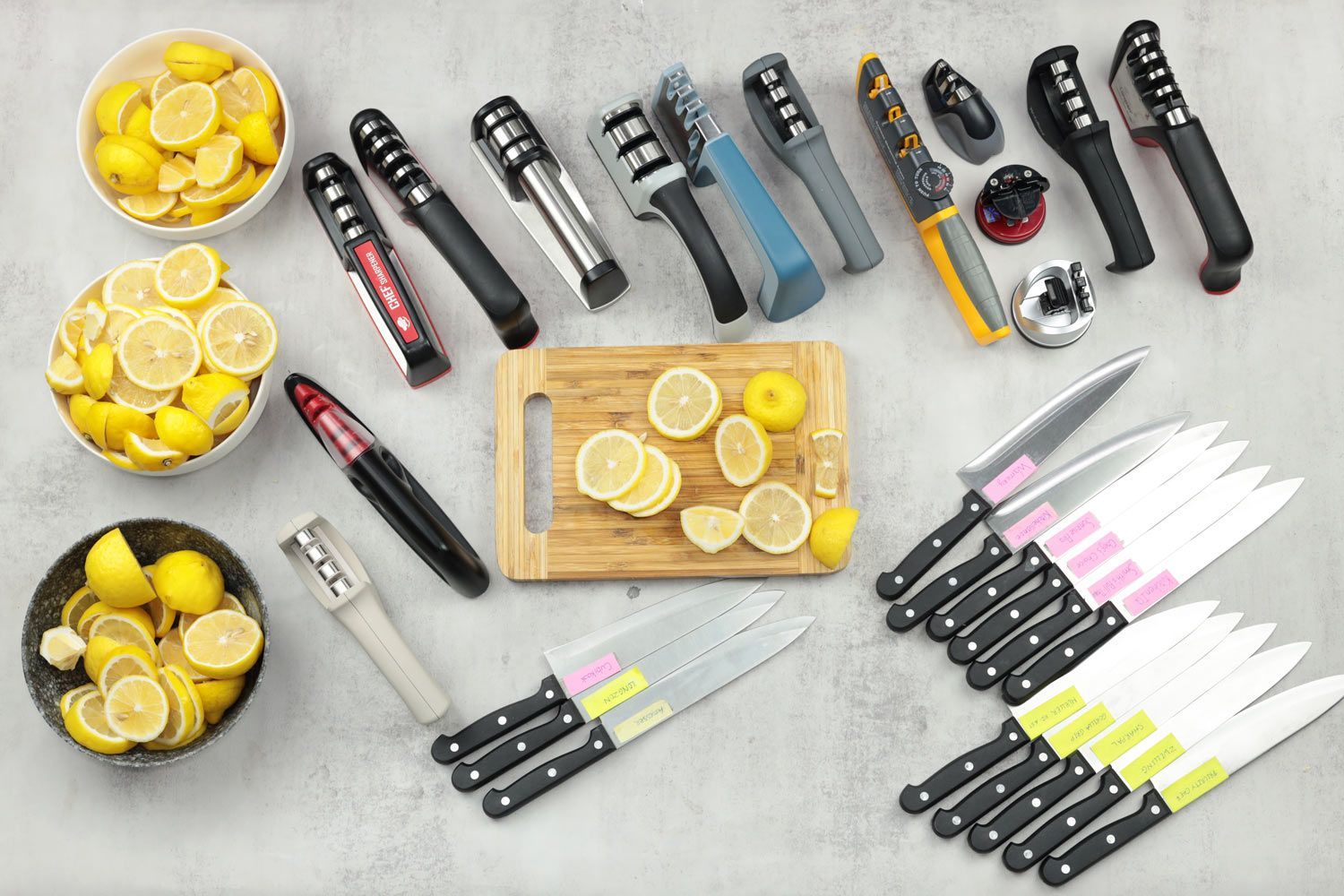Our recommendations are made independently. We may receive commissions from purchases made via our links.
How to Sharpen a Knife
A complete guide on how to sharpen a knife with stones, steels, and handheld sharpeners, plus veteran's tips on knife sharpening.
Knowing how to sharpen a knife is a critical skill for any aspiring chef. Rare is the recipe that doesn’t require cutlery.
Just like a painter’s brush, a properly sharpened knife functions as an extension of the cook’s mind. It allows you to be creative in your preparation, and acts as an aid rather than a barrier to completing your task.
Knives dull with time and use. The dull blade will slow you down, make you work harder, and reduce the precision of your cuts.
The change happens very imperceptibly but if you keep that at the back of your mind, it’s not hard to detect a dull edge. It’s also not hard to return your blades to full functionality. All you need is a good knife sharpener and diligent practice.
Does Your Knife Need Sharpening?
Knife manufacturers practice an exacting science in the creation of your cutlery. Straight out of the factory, they’re almost always super sharp. Steel is tough stuff, but it will gradually wear down. Different metals and different edge angles dull at different rates. You need to be able to identify a dull edge.
Luckily, you don’t need a micrograph to evaluate your knives’ sharpness. One of the most common techniques is the paper test.
Grab a piece of printer paper. Hold it by the corner and cut downward starting at the edge. If your blade cuts cleanly through the paper without tears, it’s still sharp! If not, it’s time to do a little sharpening or at least honing.
Another common test makes use of a tomato or onion. A sharp knife will cut through the tough peel with minimal force (in the case of the tomato, you’ll also notice the innards don’t get squished). If the procedure requires much force or sawing motion, your knife is dull.
A sharp knife will cut through ripe tomatoes without squishing the innards
How to Hone a Knife Using a Sharpening Steel
A honing or sharpening steel is a metal rod designed to make quick fixes to your blades. Many knife sets include a sharpening steel. They’re usually on the order of about 9 inches long.
In technical terms, the sharpening steel is a honing tool rather than a sharpening tool. Sharpening a blade involves removing a bit of metal to give it a new edge. Honing, on the other hand, is basically smoothing out the existing metal.
As you use your knife, the thin metal that makes up the edge will develop slight bends and curls. These are usually microscopic, but they make a difference. Running a harder object like a sharpening steel or a ceramic honing tool (or even a ceramic bowl) along the edge helps smooth out those defects. It takes a little practice, though.
There are many techniques to honing with a sharpening steel. The vertical stroke method is the safest and simplest, so that’s what we recommend.
Here's how to hone a knife with a sharpening steel using the vertical stroke:
- Hold the steel vertically with the tip down and pressed firmly on your work surface. Try not to let the steel slide while you’re honing the knife. It should be close to arm’s length from you, but not to such an extreme that the steel or the knife is hard to control.
- Place the heel of your blade against the top of the steel. The tip should point slightly upward.
- Angle the knife so that there’s about 15 degrees between the flat side of the blade and the rod.
- Maintain that angle while sliding the knife downwards and pulling it toward your body.
- Repeat this motion 4-5 times.
- Switch to the other side of the blade and repeat.
Once you’ve mastered the vertical stroke, you can try flashier techniques if you wish. Your vegetables won’t care which method you employ. Since vertical strokes are safer and require less practice to perfect, it’s the best option for most people.
No matter how you do it, honing goes a long way toward keeping your knives sharp. If you hone frequently (after every few uses) those blades will survive a long time between actual sharpening. You’ll probably find you only have to do a serious sharpening once a year.
How to Sharpen a Knife
To reiterate: the sharpening process removes small amounts of metal from the blade. It’s very much analogous to sanding wood. That means the sharpener (unlike the honing tool) must be abrasive. Some sharpening tools use natural stone while others use other artificial materials with embedded diamond dust or other tough abrasives.
Whetstones
The whetstone is the classical knife-sharpening tool. Even if you don’t know the name, you’ve probably seen movie characters running a stone along their sword’s edge. Whetstones have advanced a bit in the past century, but much like their ancient counterparts they still take practice. Plus, you need multiple stones of varying grits to truly do the job right. That can all be quite a nuisance since they’ll only get used once or twice a year.
Whetstone marketers have come up with many ways to package their products and aid your work. Most modern whetstone sets include some type of angle guide. This goes a long way toward helping you maintain the right angle, but it can still be awkward.
If you get pleasure out of caring for your blades, you may enjoy the whetstone process. There is certainly an art to this type of sharpening. For a select few users, it can almost become a form of meditation. Plus, there is something undeniably appealing about seeing your partner methodically maintaining the family cutlery. Or maybe we’re reading too much into it.
For many among us, traditional sharpening with a whetstone is more tedious than calming. Fortunately, there are many other options in this day and age. Read our post on How to Sharpen a Knife with a Stone for a step-by-step guide.
Professional Sharpening Services
Casual home cooks may find it simplest to just bring their knives to a professional for sharpening. Once a year is all they need, especially if the blades get honed regularly. Many hardware stores offer this type of service on site. Alternately, some manufacturers offer to restore your knives to factory sharpness if you send them in. It’s not fun to be without your good knives for a week or two, but you’ll have fantastic edges afterwards.
The drawback to professional sharpening services is the cost (not to mention the inconvenience). We can’t all afford to do it regularly. That’s where the other at-home methods come in.
Handheld and Tabletop Sharpeners
You’re likely aware of the small handheld sharpening tools with V-shaped tungsten carbide abrasives. They can be found very cheaply nowadays. The problem is they don’t offer a complete solution. Quality sharpening involves multiple steps for much the same reason that sanding wood requires multiple steps. One must go from rough grit to fine to get a refined edge.
The good middle ground between whetstone sets and handheld carbide scrapers are multi-step pull-through sharpeners. These have multiple grit levels to both remove damaged metal and refine the new edge. And the process is intuitive, so you don’t have to worry much about the knife’s angle.
Many multi-stage sharpeners also include a final ceramic honing stage. To a large extent, having a honing slot on your sharpener means you don’t need a separate honing steel. Just draw your knives through the honing slot every so often to iron out minor imperfections.
The majority of multi-stage sharpeners have fixed V-shaped sharpening tools which you draw the blade across. They come at reasonable prices and can be found at any kitchenware shop.
A few others are motorized and make use of small, spinning grinding wheels. These are more expensive, of course. They work well, but whether or not they’re worth the price is debatable.
A word of caution for multi-slot sharpeners: It’s tempting to run your knives through all the stages each time you sharpen, but it’s best not to do so. The coarse stage removes a lot of material. Overuse of the coarse sharpening stage will scrape metal off your blade unnecessarily. Use the honing stage often, and the mid-level stage a few times a year. The coarse slot can be reserved for that once-yearly deep-level sharpening.
Grinding Wheel
One other sharpening method you may not think about is the grinding wheel. In this case we’re not talking about the tiny wheels in electric tabletop sharpeners. Think machine-shop industrial table grinder! There are a few large grinding wheels out there that are intended for blade sharpening tasks.
These large grinding wheels may include an integrated clamp to keep hold of your blade at the proper angle. It’s rare for an individual to feel the need for a sharpener like this, though. They’re more likely to be used by specialized businesses like those you’d bring your knives to for an annual sharpening.
Edge Angle
The next thing to consider is edge angle. Some sharpeners won’t give you the same angle that the knives’ manufacturer did.
Every knife has a certain bevel angle to its edge. The most common for European style chef’s knives are set at 20 degrees on each side of the edge. That means to sharpen it properly, the sharpening surface needs to be set at that angle too.
Other knives may come with a shallower-angled bevel. Japanese Santoku knives, for instance, traditionally get a 15-17 degree bevel on only one side (the other side being vertical). To restore a dull Santoku you’d need a different sharpening setup than for a dual-beveled European blade.
Some sharpening systems such as rod-and-jig whetstone sets allow you to select the angle you desire. They are, sadly, some of the more tedious to use. Simpler V-shaped slot sharpeners only work for one set angle.
If your knife collection includes multiple bevel angles, you may be stuck with the more complex systems. Or you may wish to get one sharpener that suits most your knives and send the others to a professional.
Serrated Knives
Serrated knives are a special case. Neither ordinary whetstones nor pull-through sharpeners will work for them. Fortunately, only the tips of the serrations dull quickly, so overall, they stay sharp longer. If you get an electric sharpener with a flexible stropping wheel (emphasis on flexible!), you can use that for honing.
Usually your best bet for actually sharpening a serrated blade is to send it to a professional.
There are rod-shaped sharpener tools out there that you can use to sharpen the scalloped serrations. The process is just mind-numbingly tedious.
So what solutions do we suggest? Like so many things in life, there’s no single choice for “best knife-sharpening method.” The best one for you is that which you can afford and which you don’t mind using when necessary.
If you enjoy it, some form of whetstone is probably for you. If not, or if you don’t want to spend much time, a multi-stage pull-through sharpener will likely serve you well.
Happy sharpening!

